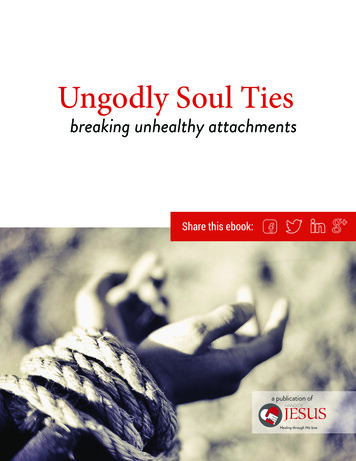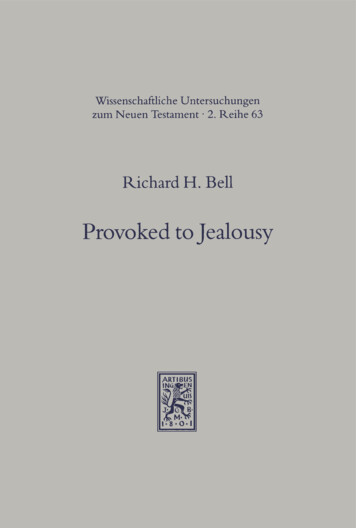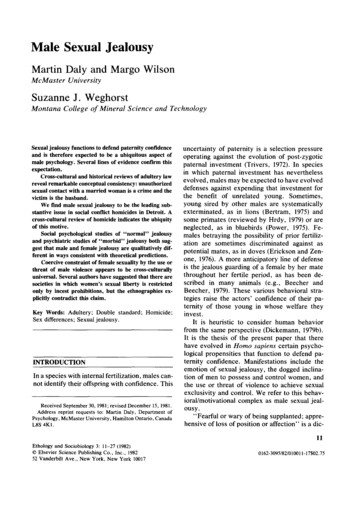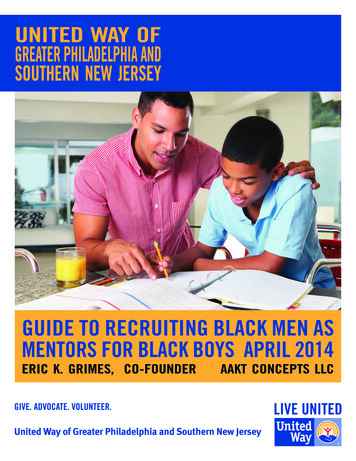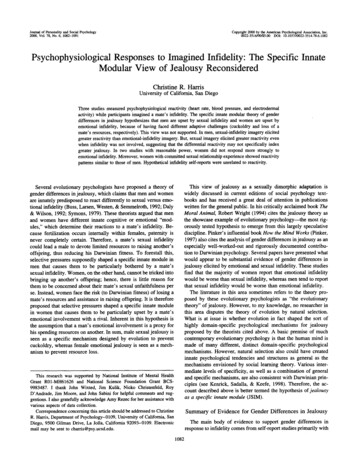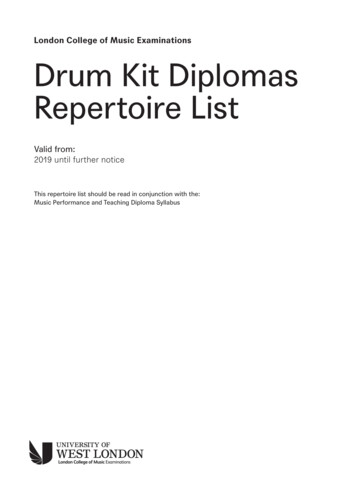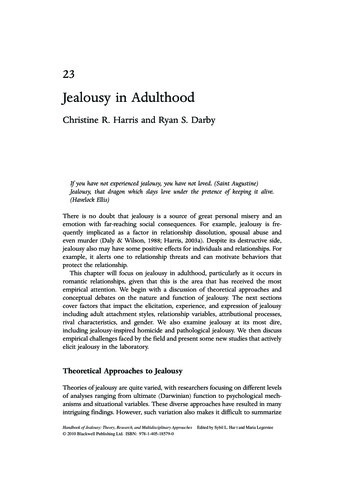
Transcription
Hart: Handbook of Jealousy, Theory, Research, and Multidisciplinary Approaches 9781405185790 4 023Final Proof page 547 12.2.20103:04pm23Jealousy in AdulthoodChristine R. Harris and Ryan S. DarbyIf you have not experienced jealousy, you have not loved. (Saint Augustine)Jealousy, that dragon which slays love under the pretence of keeping it alive.(Havelock Ellis)There is no doubt that jealousy is a source of great personal misery and anemotion with far-reaching social consequences. For example, jealousy is frequently implicated as a factor in relationship dissolution, spousal abuse andeven murder (Daly & Wilson, 1988; Harris, 2003a). Despite its destructive side,jealousy also may have some positive effects for individuals and relationships. Forexample, it alerts one to relationship threats and can motivate behaviors thatprotect the relationship.This chapter will focus on jealousy in adulthood, particularly as it occurs inromantic relationships, given that this is the area that has received the mostempirical attention. We begin with a discussion of theoretical approaches andconceptual debates on the nature and function of jealousy. The next sectionscover factors that impact the elicitation, experience, and expression of jealousyincluding adult attachment styles, relationship variables, attributional processes,rival characteristics, and gender. We also examine jealousy at its most dire,including jealousy-inspired homicide and pathological jealousy. We then discussempirical challenges faced by the field and present some new studies that activelyelicit jealousy in the laboratory.Theoretical Approaches to JealousyTheories of jealousy are quite varied, with researchers focusing on different levelsof analyses ranging from ultimate (Darwinian) function to psychological mechanisms and situational variables. These diverse approaches have resulted in manyintriguing findings. However, such variation also makes it difficult to summarizeHandbook of Jealousy: Theory, Research, and Multidisciplinary Approaches 2010 Blackwell Publishing Ltd. ISBN: 978-1-405-18579-0Edited by Sybil L. Har t and Maria Legerstee
Hart: Handbook of Jealousy, Theory, Research, and Multidisciplinary Approaches 9781405185790 4 023Final Proof page 548 12.2.20103:04pm548 Christine R. Harris and Ryan S. Darbymajor theoretical ideas in the field since researchers use a number of differentterminologies and often do not place their findings in any larger theoreticalframework. In this chapter, we will describe some of the more prominent ideasand try to draw connections across different approaches where possible. The firstfew theoretical issues we will discuss are conceptual or definitional in nature.Defining featuresFor most theorists, the most defining features of jealousy are that it requires asocial triangle and occurs when someone perceives that another person (whomay be real or imaginary) poses a potential threat to an important interpersonalrelationship (e.g., Parrott & Smith, 1993; Mathes, 1991; Salovey & Rothman,1991; White & Mullen, 1989). Rejection, or fear thereof, can also be integral injealousy. The rejection that induces jealousy is proposed to be different fromsome other types of rejection in that one’s interpersonal loss involves another’sinterpersonal gain (Parrott, 1991; Mathes, Adams, & Davies, 1985).Jealousy is generally agreed to be an emotion that serves to motivate behaviorsthat protect one’s relationship from potential usurpers. As we will see, sometheorists have focused on immediate consequences of jealousy-induced behaviorsfor individuals and relationships, whereas others have theorized about possible(Darwinian) functions in remote human ancestral past.Most of the work on jealousy in adults has focused on jealousy in romanticrelationships. However, several theorists have argued that the same basic processthat produces jealous feelings in sexual relationships also leads to jealousy that arisesin other kinds of relationships such as friendships or between siblings for a parent’sfavor (DeSteno, Valdesolo, & Bartlett, 2006; Harris, 2003a; Parrott, 1991; Salovey &Rodin, 1984). For many, the first pangs of jealousy may arise during competition withsiblings for parental attention (Trivers, 1972; Volling, McElwain, & Miller, 2002).Jealousy: A blended or specific emotion?The exact nature of the emotional underpinnings of jealousy and the processesthat give rise to it are debated. Some have suggested that jealousy involvesdifferent component emotions such as anger, fear, and sadness. One possibilityis that all of these emotions are experienced simultaneously (Sharpsteen, 1991).Another hypothesis is that the specific emotion one feels changes over the courseof a single jealous episode as appraisals of the situation change (Hupka, 1984).A third possibility is that jealousy is a term that encompasses any of a variety ofthoughts and feelings that arise within a specific type of social situation, namely, alove triangle (White & Mullen, 1989). There seems little doubt that variousemotions can occur in situations that invoke jealousy or as a result of attemptingto cope with jealousy. However, others see jealousy as a distinct affective statewith its own unique motivations, separate from other emotions.
Hart: Handbook of Jealousy, Theory, Research, and Multidisciplinary Approaches 9781405185790 4 023Final Proof page 549 12.2.20103:04pmJealousy in Adulthood 549One way researchers have tried to understand distinct emotions is by focusingon their ultimate functions (Frijda, 1986). From this perspective, emotionsare motivational states that have been shaped by natural selection. Each emotionfunctions to motivate one to engage in certain behaviors that one mightotherwise not engage in—behaviors that have, over phylogenetic history, tendedto confer some adaptive advantage in some set of situations (Ekman, 1992;Frijda, 1986; Keltner & Haidt, 1999). Each emotional state is proposed to haveits own distinct motivational tendencies or ‘‘urges’’ (Frijda, 1986) that are activated by particular appraisals. For example, fear is induced by the appraisal ofthreat, even if not conscious, and motivates escape from or avoidance of thedangerous stimuli.One functional view proposes that jealousy evolved as a specific emotion tomotivate behaviors that break up or prevent, either psychologically or physically,the threatening liaison that is perceived to exist between an important other and arival, and thereby, protect the primary relationship (Harris, 2003a). Importantly,this motivational state would not be created automatically by other emotions thatare frequently offered as the more essential emotional components of jealousy(namely, anger, fear, and sadness). Threats to usurp relationships likely hadimportant consequences for one’s Darwinian fitness given that relationships,whether romantic/sexual or not, provide a variety of important benefits to anindividual (Baumeister & Leary, 1995; House, Landis, & Umberson, 1988). Forexample, jealousy over siblings may have ensured that one received one’s necessary share of a parent’s limited time, affection, food, etc. (Trivers, 1972).As noted above, most researchers who take a specific emotions view ofjealousy assume that it was selected for by natural selection. However, theoriesof jealousy as a blended emotion are also potentially compatible with the ideathat jealousy is an evolved adaptation.Appraisals in JealousySome researchers who employ a specific emotions perspective focus on theappraisals that give rise to jealousy (Lazarus, 1991; Harris, 2003a). Although theappraisal and motivational approaches can be viewed as distinct, they are generally complementary and in practice often tend to differ only in a matter of whichaspect of an emotional episode is emphasized (Lerner & Tiedens, 2006).Primitive and elaborated jealousyOne possible model of jealousy is that it has a primitive or ‘‘core’’ form that canbe elicited by a primary appraisal of threat that arises from input as simple as theperception that a loved one has turned their attention to a potential rival andaway from the self (Harris, 2003a). The jealous state would then motivate
Hart: Handbook of Jealousy, Theory, Research, and Multidisciplinary Approaches 9781405185790 4 023Final Proof page 550 12.2.20103:04pm550 Christine R. Harris and Ryan S. Darbybehaviors designed to restore the loved one’s attention to the self. Ontogeneticstudies that find jealousy in infants as young as 6 months and cross-species workthat documents behaviors resembling jealousy in nonhuman animals would beconsistent with the view that minimal cognition, which need not be conscious, isnecessary for the elicitation of jealousy (Cubiciotti & Mason, 1978; Hart &Carrington 2002; see also other chapters in this volume).However, at least in humans, jealousy can also take on a more elaborate form.With cognitive development, triggers for jealousy become more sophisticated.For example, work by Masciuch and Kienapple (1993) finds that even by 4 years ofage, the specifics of a social triangle influence whether jealousy arises. Childrenwho were 4 or older expressed more jealousy over their mothers interacting witha similar-aged peer than with an infant. Jealousy in younger children was notaffected by the age of the rival. One possibility is that in this situation, olderchildren have learned that babies require special attention. Therefore, one’smother paying attention to an infant is perceived as less threatening relative toher appearing to favor a peer who is more similar to oneself. Thus, it seems thatover the course of development, an individual’s social and cognitive appraisals ofthe meaning of the interactions between the rival and the loved one becomeincreasingly important in the evocation of jealousy.Appraisals also play an important role in the progression of jealous affect.Extension of Richard Lazarus’s (1991) theory of emotions may illuminate thisprogression. After the initial appraisal of threat to the relationship, one immediately engages in further cognitive assessments. These secondary appraisals include trying to determine the scope of the threat as well as attempts to cope withit (e.g., I’ll put a stop to this; Is my partner going to leave me?; It is my own fault thatthis happened?). As one attempts to further assess and to deal with the jealoussituation, other secondary emotions such as anger, fear, and sadness are likely tobe elicited.Social cognitive perspectiveGiven that many theorists have emphasized the importance of cognitive appraisals in the elicitation of emotion, it is not surprising that much of the workon jealousy in adults has employed a social cognitive framework. Research in thistradition has focused on two general features that make a partner’s involvementwith another particularly threatening. The first is the potential loss of relationshiprewards. Many of the benefits that are obtained from interpersonal relationshipsare finite, such as money or resources. Even intangible rewards like affection andattention that may seem infinite are limited by time. Therefore, if a relationshippartner is providing these benefits to someone else, it can be at a cost to oneself.This is likely one of the reasons why the arrival of a new sibling can beparticularly difficult for a child—the exclusive attention and affection that weretheirs are now shared. Interestingly, the same underlying process may also be
Hart: Handbook of Jealousy, Theory, Research, and Multidisciplinary Approaches 9781405185790 4 023Final Proof page 551 12.2.20103:04pmJealousy in Adulthood 551responsible for the feelings that new fathers sometimes express when their wives’attention is consumed by a newborn.A second factor that plays an important role in jealousy is threat to representations of the self. The existence of a rival can be particularly threatening becauseit challenges some aspect of a person’s self-definition (Parrott, 1991), self-identity(Salovey & Rothman, 1991), or self-esteem (Mathes, 1991). Several theorists havenoted the importance that relationships play in defining the self and self-worth.Therefore, rivals to relationships not only threaten relationship rewards, but alsothe very value of the self. For example, when faced with a partner’s infidelity,people appraise the meaning of the betrayal in terms of the implications aboutthe self (Did she have sex with him because I’m a bad lover? Or because I amunattractive?). The answers to such questions will impact the intensity of thedistress. According to Salovey and colleagues’ ‘‘domain relevance hypothesis,’’rivals who surpass an individual in domains that he or she finds important andrelevant to his or her self-definition are most likely to evoke jealousy (Salovey &Rothman, 1991; Salovey & Rodin, 1984; Tesser, 1988). Research on this topic willbe discussed in a later section. Jealousy may be particularly likely to occur whenthe threatened relationship involves a person to whom one is sexually attracted orinvolved with because of the special importance of romantic relationships inself-esteem and in providing relationship rewards (White & Mullen, 1989).Attachment Style and JealousyRomantic relationships seem to be formed, at least partially, through attachmentprocesses that are similar to those which occur between infants and theircaregivers (Hazan & Shaver, 1987). Roughly defined, an attachment relationshipis an emotional or affectionate bond with another individual. As discussed in JohnBowlby’s (1969) seminal work, infants are predisposed to form emotional connections with their caregivers. This encourages caregivers to remain close toinfants in order to provide security and care. Work by Bowlby and others,however, has shown that attachment relationships differ qualitatively.The primary caregiver is hypothesized to play an important role in creatingattachment style differences. Although some caregivers will respond immediatelyto an infant’s distress by holding and comforting the baby, other caregivers maybe more distant or inconsistent in their responses. Over time, based on theseexperiences, an infant develops expectations of what to expect from others andtherefore what to expect from the self (Bowlby, 1969). For example, if the primarycaregiver is non-responsive to the needs of the child, the child learns that othersare not to be depended upon and that he or she must depend upon the self, whichis characteristic of some forms of the insecure-avoidant attachment style. If themother is responsive to the child and fills the child’s needs, the child adopts apositive view of others and self, which is characteristic of the secure attachment
Hart: Handbook of Jealousy, Theory, Research, and Multidisciplinary Approaches 9781405185790 4 023Final Proof page 552 12.2.20103:04pm552 Christine R. Harris and Ryan S. Darbystyle (Bartholomew, 1990). Development of attachment style is also likely to beinfluenced by the infant’s temperament as well as the interaction betweentemperament and the caregiver’s ability or desire to respond appropriately tothe particular physical and emotional needs of the infant. In childhood, the threemost common attachment styles are secure, insecure-avoidant, and anxious (alsocommonly referred to as the ambivalent attachment style because of a tendencyto draw caretakers in and then push them away). This early attachment processbetween the primary caregiver and the child acts as an archetype for futureattachment relationships, such as romantic relationships (Hazan & Shaver, 1987).In work with adults, Hazan and Shaver (1987) have found analogous attachment styles between adult romantic attachments and infant caregiver attachments. In adulthood, individuals with a secure attachment style tend to be moreconfident in themselves and in their partners. They also tend to view theattachment relationship as a positive source in their lives and find it easy toestablish romantic relationships with little anxiety over possible abandonment.These appraisals and behaviors are markedly different than the anxious/ambivalent attachment style. Anxious individuals also view attachment relationshipspositively, yet they are anxious in the attachment relationship. They have apervasive worry of abandonment because they fear they may not be deservingof love (Hazan & Shaver, 1987). The prototypical insecure-avoidant attachmentstyle has a negative internal working model of others (Bartholomew, 1990).Individuals with this attachment style have little confidence in other people andas a result rarely find security in attachment relationships. Some modern theorists, such as Bartholomew (1990), separate the negative internal working modelof others into two different attachment styles, fearful and dismissing. The formeris characterized by a fear of attachment relationships, while the latter ischaracterized by a lack of need for attachment relationships. In this chapter, wewill focus on the original Hazan and Shaver definition and include individualswith a negative others model under the umbrella of the insecure-avoidantattachment style.Returning to the topic of jealousy, it is easy to imagine how attachment styleand jealousy may be interrelated. At its simplest, jealousy is the feeling that ariseswhen an attachment relationship is threatened by a third party. Given thatattachment styles are associated with different expectations of relationships, ithas been proposed that each style has a somewhat different reaction to possiblerelationship threats. As Sharpsteen and Kirkpatrick (1997) aptly point out, ‘‘because romantic relationships are likely to be attachment relationships, individualdifferences in jealousy are likely to parallel individual differences in attachmentbehavior’’ (p. 628). Although several studies have examined the relationshipbetween adult attachment styles and jealousy, their findings, at least at firstblush, appear inconsistent. For example, some studies suggest that jealousyis more common in insecurely attached individuals, and yet other studiessuggest that securely attached individuals are more likely to show jealous anger
Hart: Handbook of Jealousy, Theory, Research, and Multidisciplinary Approaches 9781405185790 4 023Final Proof page 553 12.2.20103:04pmJealousy in Adulthood 553(Buunk, 1997; Sharpsteen & Kirkpatrick, 1997). In the next section, we willdiscuss such research and will present a model that may help shed light onthese apparently discrepant findings.Attachment and threat—a two-stage modelWe propose that one important variable that is likely to moderate an attachmentstyle’s impact on jealous reactions is stage of threat. For example, is the threatmerely a vague possibility or is it a definite reality? The first stage of this model,appraisal of a threat, occurs when an individual is just becoming cognizant of apossible rival. Not all social relationships between the partner and others willactually interfere with one’s romantic relationship. In order for jealousy to beelicited, the individual must appraise that on some level the new presence is infact vying for the attention of the partner or is a potential threat to the relationship. Individuals differ in their propensity toward appraising possible rivalthreat. Some have low thresholds resulting in almost any new presence beinginterpreted as a rival. Others have high thresholds and rarely appraise another asan interloper. Thus, the initial stage in the jealousy experience focuses on whetheror not a threat from a rival subjectively exists.The second stage of the jealousy experience is the reaction to the threat. Oncea potential rival passes the threat threshold, he or she is determined to be a realrival. At this point, individuals engage in additional coping mechanisms, whichinclude reacting to the threat. Determining how to respond to feelings of jealousyis an integral part of the jealousy experience. We now turn to discussingdifferences in attachment styles in these two stages of the jealousy experience.Secure attachment stylePeople with a secure attachment style have positive mental models of themselvesand others. They put value in relationships and tend to have longer-lasting andmore successful relationships (Kirkpatrick & Hazan, 1994). The success of theirrelationships has led researchers to two seemingly contradictory hypothesesregarding their jealousy experiences. The secure/low reactive hypothesis proposes that secure individuals feel less jealousy. The thought is that since thesepeople tend to have successful relationships in which both they and their partnersare happy, there is probably little reason for them to fear threat from possiblerivals. Thus, they should feel less jealousy. In contrast, the secure/high reactivehypothesis predicts that secure individuals should show at least similar levels orperhaps even greater jealousy compared to people with other attachment styles.In particular, they may be more prone to jealous anger or may engage in moreovert actions in response to their jealousy (Sharpsteen & Kirkpatrick, 1997). Assecure individuals especially value attachment relationships, they may be moreprone to employ jealousy to protect their important relationships. On this view,
Hart: Handbook of Jealousy, Theory, Research, and Multidisciplinary Approaches 9781405185790 4 023Final Proof page 554 12.2.20103:04pm554 Christine R. Harris and Ryan S. Darbyjealousy may help maintain the relationship by motivating the individual toeliminate possible threats to the relationship. The secure/high reactive hypothesisis consistent with a functional approach that jealousy evolved to preserve attachment relationships.Empirical work on secure attachment style and jealousy finds supportiveevidence for both hypotheses. Studies that ask participants to anticipate theirlevels of jealousy tend to find that secure individuals anticipate feeling less jealousthan insecurely attached individuals (Buunk, 1997). However, studies that askparticipants to recall instances that made them jealous tend to find little difference in jealousy levels between securely attached individuals and insecurelyattached individuals (Sharpsteen & Kirkpatrick, 1997).We suggest a way to reconcile these apparently contradictory findings. Attachment style may differentially impact jealousy depending on the temporal aspectof jealousy, namely, whether the threat is in the process of being appraised or isalready certain. We propose that in the first stage, the appraisal stage, securelyattached individuals are likely to have a higher threshold for appraising potentialthreat and are therefore likely to have less frequent bouts of jealousy. In thesecond stage, after the threat is certain, secure individuals are more likely to reactwith jealous anger.During the first stage of jealousy, secure individuals are probably less likely toappraise others as possible threats because secure individuals have a positivemental model of their partners and therefore do not expect betrayal. Acrossnumerous dimensions of trust, including predictability, dependability, faith, andsecurity, secure individuals rate their partners higher than insecurely attachedindividuals (Simpson, 1990), which most likely translates into trusting theirpartners to not betray them with potential rivals. Experimental studies examiningthreat perception seem to confirm this hypothesis. Radecki-Bush, Bush, andJennings (1988) asked individuals to picture their partner in situations that hadbeen rated as high threat (their partner growing close to an old girl/boyfriend),low threat (their partner commenting on the attractiveness of another person), ornon-threat (their partner’s phone line being busy for a half hour). Radicki-Bushand colleagues found, that regardless of scenario type, securely attached individuals viewed the scenarios as less threatening than insecurely attached individuals.Furthermore, appraisals of threat significantly predicted the intensity of jealousy.Thus, secure individuals reported feeling less jealousy overall, which supports thesecure/low reactive hypothesis and the finding by Buunk (1997) that securelyattached individuals anticipate feeling less jealousy.Turning to the second stage of jealousy, reaction to the threat, securelyattached individuals seem to behave quite differently under circumstances inwhich a threat is more certain. When their high threshold for threat isexceeded, secure individuals appear to have strong jealous reactions. Sharpsteenand Kirkpatrick (1997) asked participants to remember times when they hadactually experienced jealousy and to report on their feelings and behaviors
Hart: Handbook of Jealousy, Theory, Research, and Multidisciplinary Approaches 9781405185790 4 023Final Proof page 555 12.2.20103:04pmJealousy in Adulthood 555during these experiences. In terms of the severity of their actual jealousyexperiences, secure individuals were not less jealous than insecure individuals.In fact, they reported feeling more intense anger than insecure-avoidant individuals and were more likely to direct that anger at their partner than either ofthe insecure attachment styles. These results lend support to the secure/highreactive hypothesis.Directing anger at the partner is also consistent with the thought that forsecurely attached individuals, jealousy may have some beneficial effects. Angerthat is directed at the partner may discourage the partner from encouraginginterloper interest. Anger that is directed at the rival only discourages that specificrival from showing interest in the partner. Rivals generally come and go butpartnerships tend to be more stable. Thus, discouraging the partner may have alonger-lasting impact on relationship maintenance than discouraging the rival. Itmay, therefore, be in the best interest of preserving the attachment relationshipthat one directs jealous anger toward the partner rather than the rival. Indeed,Sharpsteen and Kirkpatrick (1997) found that individuals with a secure attachment style were the only attachment style group to report that the jealousyexperience brought the couple closer together. Thus, it appears that jealousy can,in some respects, preserve and protect the romantic relationship of secureindividuals.Insecure attachment stylesA strikingly different picture emerges for the insecure attachment styles. Anxiously attached individuals, unlike their securely attached counterparts, have littletrust in their partners. They view themselves as unworthy of their partners’ loveor affection, and so expect their partners to abandon them at some point in theirrelationship. Simpson (1990) examined anxious attachment as a personalitydimension and found that degree of anxious attachment is negatively correlatedwith the trust individuals have in their partner. Guerrero (1998) found furtherevidence for this negative correlation in her study in which participants endorsedthe frequency of different types of jealous behaviors. Anxiously attached individuals reported that they often engaged in surveillance behavior like spying on theirpartner, keeping closer ‘‘tabs’’ on their partner, and searching for evidence ofsuspected infidelity in their partners’ belongings.The lack of trust that anxious individuals have in their partners may lead to alower threshold for threat appraisal. When given potentially threatening scenarios, such as their partner dancing intimately with someone else, anxiousindividuals foresee themselves as being more jealous than more secure individuals. They are also more concerned over the possibility of their partner findingsomeone else (Buunk, 1997). In one experimental study (Powers, 2000), participants were assigned a partner and then shown video footage of their partnerflirting with another person. Anxious individuals reported higher levels of
Hart: Handbook of Jealousy, Theory, Research, and Multidisciplinary Approaches 9781405185790 4 023Final Proof page 556 12.2.20103:04pm556 Christine R. Harris and Ryan S. Darbyjealousy than either secure or insecure-avoidant individuals. Across multiplestudies, such as these, anxiously attached individuals appear to be more sensitiveto possible threats from a rival. It appears that anxiously attached individuals havelower thresholds for threat, which make them prone to more frequent bouts ofjealousy.Reactions of anxious individuals when the threat is subjectively certain areslightly more complex. Anxious individuals tend to be low in self-regard andsometimes almost seem to expect betrayal from their partners. When betrayaldoes come, they often suppress overt anger toward their partner and rival(Sharpsteen & Kirkpatrick, 1997), possibly to avoid further rejection. Guerrero’s(1998) examination of anxiously attached individuals’ reactions to jealousyprovoking events found that they feel envy of their rivals and hurt at thepossibility of separation from their partner. However, instead of attempting toheal the damage done by the interloper, they engage in behaviors like distancingthemselves from their partner. Thus, their distancing reactions to threat appearto be more counterproductive than the jealousy expressions of the securelyattached individuals.Insecure-avoidant individuals, who put little stock in the relationship in thefirst place, appear to be the least threatened by a possible rival. Guerrero (1998)reported that individuals with negative other models (a key component of theinsecure-avoidant attachment style) are the least fearful of possible rivals to theirrelationships. As they value attachment relationships less in general, it appears asif they are the least threatened by the possibility of the relationship ending.Simpson (1990) found that of the attachment styles, insecure-avoidant individualsshowed the least remorse when the relationship ended, which is consistent withplacing lower value on relationships.When insecure-avoidant individuals do feel jealousy, they tend to directtheir anger and blame at the rival rather
Jealousy in Adulthood Christine R. Harris and Ryan S. Darby If you have not experienced jealousy, you have not loved. (Saint Augustine) Jealousy, that dragon which slays love under the pretence of keeping it alive. (Havelock Ellis) There is no doubt that jealousy is a source of great personal misery and an emotion with far-reaching social .


